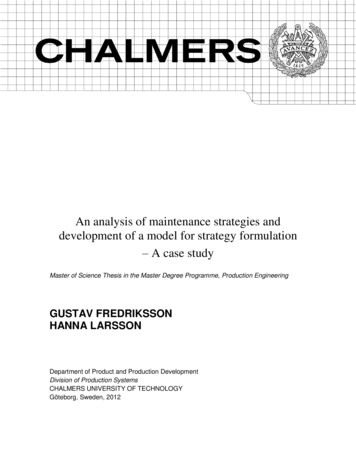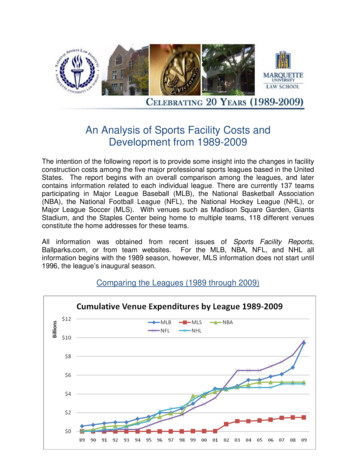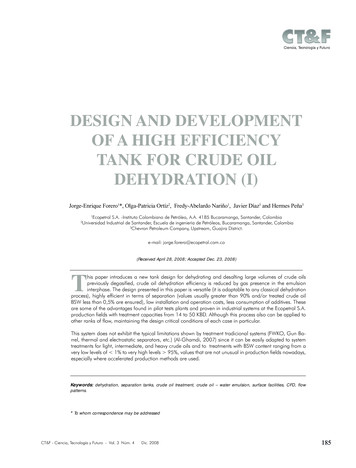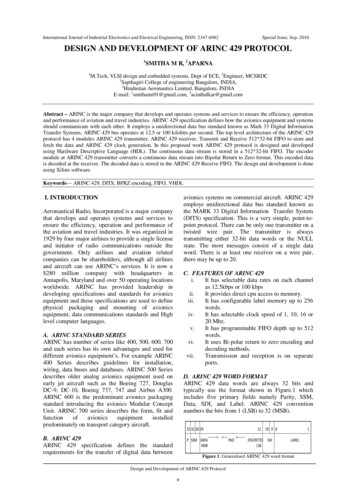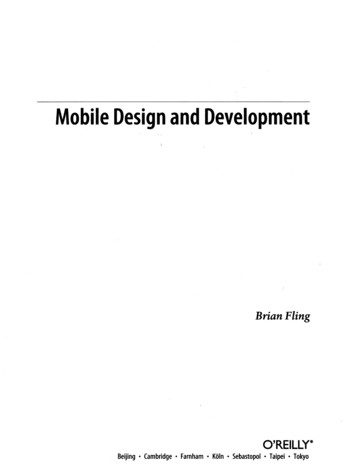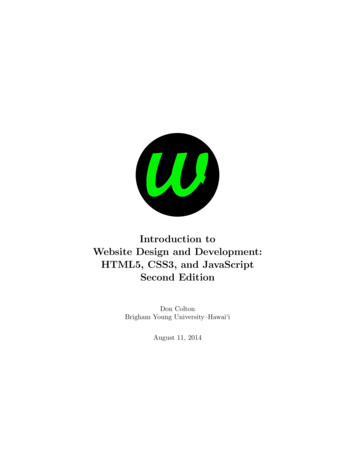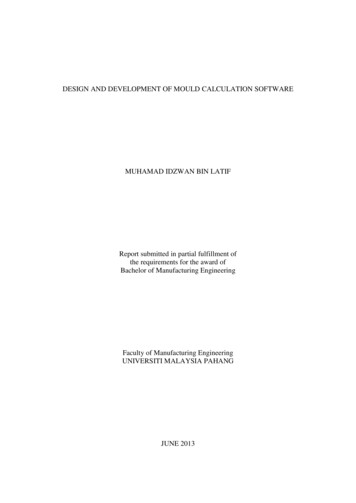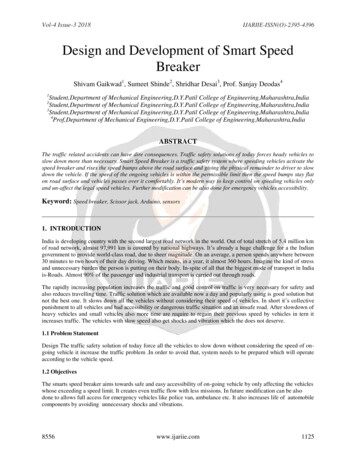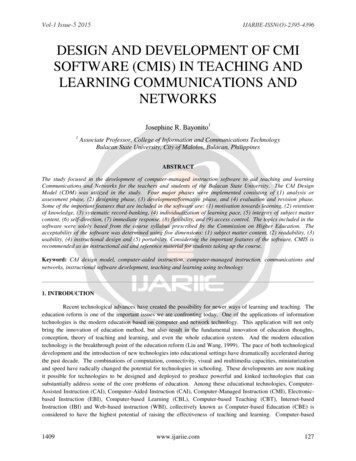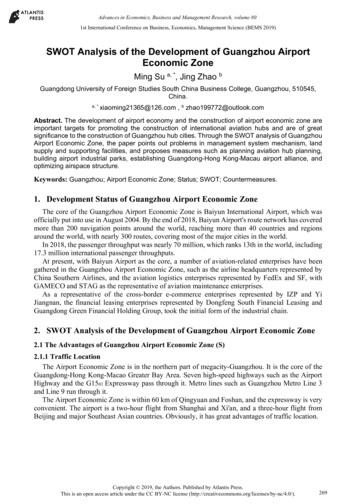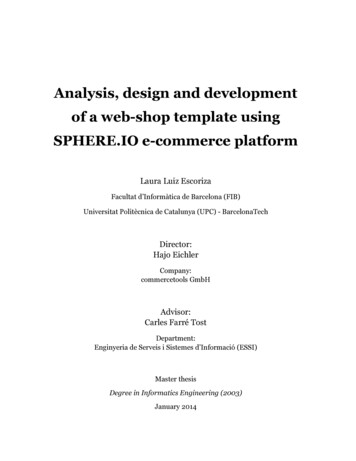
Transcription
Analysis, design and developmentof a web-shop template usingSPHERE.IO e-commerce platformLaura Luiz EscorizaFacultat d’Informàtica de Barcelona (FIB)Universitat Politècnica de Catalunya (UPC) - BarcelonaTechDirector:Hajo EichlerCompany:commercetools GmbHAdvisor:Carles Farré TostDepartment:Enginyeria de Serveis i Sistemes d’Informació (ESSI)Master thesisDegree in Informatics Engineering (2003)January 2014
2
3
DADES DEL PROJECTETítol del projecte:Analysis, design and development of a web-shop templateusing SPHERE.IO e-commerce platform.Nom de l'estudiant:Laura Luiz EscorizaTitulació:Enginyeria en Informàtica (2003)Crèdits:37,5Director:Hajo EichlerEmpresa del director:commercetools GmbHPonent:Carles Farré TostDepartament del ponent: ESSIMEMBRES DEL TRIBUNAL (nom i signatura)1. President:Antoni Urpí Tubella2. Vocal:Klaus Gerhard Langohr3. Secretari:Carles Farré TostQUALIFICACIÓQualificació numèrica:Qualificació descriptiva:Data:4
5
ABSTRACTIn the present thesis a possible next generation of e-commerce solutions with aplatform-as-a-service model is presented and analyzed. This generation triesto fill the gap of missing developer-friendly alternatives to build systems withe-commerce components. Current offered solutions are mostly aimed for thecomfortable use of designers and other non-technical roles, usually in the shapeof out-of-the-box products. These solutions are usually limiting the ability ofdevelopers to integrate technologies or build innovative business models, thussometimes forcing companies to invest in projects that have to be builtpractically from the start.This document describes the development of the first web-shop built with one ofthese solutions, SPHERE.IO, an e-commerce platform-as-a-service developedin Berlin by commercetools GmbH. During this process, questions are beinganswered about the suitability of e-commerce platforms to develop web-shops,a product most developers have to face when providing e-commerce solutionsto companies. The web-shop has a dual purpose, as it will also serve as the firstopen-source template provided by the platform to help other developers buildtheir own solutions.6
ACKNOWLEDGMENTSI would especially like to thank Hajo for accepting being the director of my thesis and readingall these endless pages despite of having so much to do (really, how can you find the time!).Thanks for your support and always good advice to improve this project.I would also like to thank all the rest of the SPHERE.IO team for creating and raising such agreat product, giving me the opportunity to work with them.From the ones that were:Aurélie, Jens, Roman, Ian, Lenni, Christian and Martin.(I loved the time we spent together, guys)To the ones that are:Nicole, Peter, Gregor, Dirk, Oleg, Nicola, Martin, Michael and Sven.I would like to thank my teacher Carles, who guided me through this project from the distance.Thank you especially for DSBW, which documentation I check constantly, not only for thisproject.Thanks to my roommate Sebastian, the most experienced online shopper I have ever met,whose advice was very convenient I must say. Thank you for helping me and have such lovingcats that kept me well entertained during the long days locked in my room.Many thanks as well to those friends that helped me somehow to be where I am now.Particularly Hèctor and Pau, who help me the most. Thank you.And of course thousand thanks to the most important person in my life, my husband Héctor,whose constant care, support and help was so necessary during all my career life.I would not be here without you, you know that.Finally, I thank my parents, from whom I inherited the love for arts and business.Because they raised me to be a person capable of anything.And I chose to be a computer engineer.7
3Background.161.3.1Whatise- ‐commerce.161.3.2Historyofe- ‐commerce.181.3.3Futureofe- sanalysis.302.2Functionalrequirements.312.3Non- ‐functionalrequirements.323Specification.348
.1.3Acceptancetests.1246.2Usabilitytests.1259
8AppendixCTestinginformation.15210
GLOSSARYAJAXStands for Asynchronous JavaScript and XML, and is a technique used on theclient side of a system to perform asynchronous operations (althoughsynchronous are also allowed), such as communicating with a server, withoutkeeping the client idle. The use of XML is not required despite the name.APIStands for Application Programming Interface, and in general means aspecification that defines how to interact with another software component.CDNStands for Content Management Network, and it is a large distributed system ofservers deployed in multiple data centers across the Internet, allowing to servercontent with high availability and performance.CSSStands for Cascading Style Sheets, and is a style sheet language used fordescribing the look and formatting of a document written in a markup language.DOMStands for Document Object Model, and is an object model and programminginterface for documents, such as HTML, in which case defines all elements asobjects with associated properties, methods and events.HTMLStands for HyperText Markup Language, and is a markup language designedfor creating web pages.HTTPStands for Hypertext Transfer Protocol, and is an application protocol fordistributed, collaborative, hypermedia information systems.HTTPSStands for Hypertext Transfer Protocol Secure, and is the result of layering theHTTP protocol on top of the SSL/TLS protocol, in order to add securitycapabilities of SSL/TLS to standard HTTP communications.IDEStands for Integrated Development Environment, and is a software applicationthat provides support for software development; usually in the areas of sourcecode edition, build automation and debugging.InternetGlobal system of interconnected computer networks that use the standardTCP/IP to communicate.11
JSONStands for JavaScript Object Notation, and is an open standard format that useshuman-readable text to transmit data objects consisting of attribute-value pairs.JVMStands for Java Virtual Machine, and it a virtual machine that can execute Javabytecode.OAuthA protocol for authentication and authorization.PaaSStands for Platform-as-a-Service, and is a category of cloud computing servicesthat provides a computing platform as a service, so that the consumer createssoftware using tools and/or libraries from the provider.PCISee PCI DSS.PCI DSSStands for Payment Card Industry Data Security Standard, and includes a set oftwelve specific requirements to cover six different goals, in order to create asecure environment for payment data.PHPStands for PHP: Hypertext Preprocessor, and is a server-side scripting languageoriginally designed for web development.RESTStands for Representational State Transfer, and is an architectural style fordesigning networked systems, based on a set of principles, such as usingstateless requests or a uniform interface for resources.RESTfulA RESTful system follows REST architectural principles and uses HTTP as atransmission protocol.TCP/IPStands for Transmission Control Protocol/Internet Protocol, and is consideredthe Internet protocol suite, as it is the combined use of the TCP transportprotocol and the IP communication protocol.SaaSStands for Software-as-a-Service, and is a category of cloud computing servicesthat provides a complete software, along with its data, as a service.ScalaA object-functional programming language that runs on JVM and is compatiblewith Java scripts.SDKStands for Software Developer Kit, and is a set of software development tools tocreate applications for a certain software package.12
SEOStands for Search Engine Optimization, and means to improve the rankingposition of a website in Internet search engines.SMTPStands for Simple Mail Transfer Protocol, and is a standard for emailtransmission through the Internet network.SSL/TLSStands for Transport Layer Security/Secure Sockets Layer, and are two relatedcryptographic protocols designed to provide communication security overInternet.URLStands for Uniform Resource Locator, and is a specific character string thatconstitutes a reference to a resource, also known as web address when usedwith HTTP.WWWStands for World Wide Web, also known as W3 or simply the Web, and is asystem of interlinked hypertext documents accessed via the Internet with a webbrowser.XMLStands for Extensible Markup Language, and is a markup language that definesa set of rules for encoding documents in a format that is both human-readableand machine-readable.13
1 INTRODUCTIONTraditional companies and institutions are making use of e-commerce to overcome theboundaries of space and time: it allows them to globalize their operations and offer a morepersonalized service to the customer. Moreover, many entrepreneurs took advantage of thebenefits of e-commerce and created new business models1.E-commerce has greatly evolved for forty years of existence and is still evolving continuously,as well as the software offered to support it. When searching for e-commerce solutions, almostall offered systems are focused on building web-shops, despite of the fact that electroniccommerce is not just about web shopping any longer.1.1 MOTIVATIONAs it will be demonstrated in the section Current Alternatives 1.3.4, it is safe to say thatcustomizable software solutions are too rigid to give an efficient and profitable answer to afuture e-commerce context. So instead of offering a final product pre-built on top of an ecommerce platform and customize it to fit the merchant’s needs, why not provide a robust andflexible e-commerce platform to let merchants build what they need from the beginning?It was that particular question that led the team of SPHERE.IO to design and develop this newcommerce platform-as-a-service. Their main goal was creating an e-commerce platform with aset of tools to allow developers to easily access and process all commerce data from within anykind of application.The SPHERE.IO backend system, where all commerce data is stored, is directly accessible viaa RESTful web API, allowing any external system to use the data, regardless of theprogramming language or chosen framework. In order to provide a more comfortabledevelopment experience, they built the first of many open-source client libraries to come: aJava client library. On top of it they created the SPHERE.IO Play SDK, a toolkit especiallyaimed for building web applications with ease using the Play web framework (Figure 1.1).1Deal-of-the-day (short time limited offers) or Discovery Commerce (periodical delivery of selectedgoods) are only some of the new business models that became popular thanks to e-commerce [Pie12].14
Figure 1.1: Diagram of a typical Java web application using SPHERE.IO.Since no system has ever been developed with this platform before, except for some smalltesting sites, it is required to implement a realistic e-commerce application on top of it in orderto test its benefits and correct its flaws. It is also necessary to have a bootstrap project fromwhich other future internal or external projects may reuse its code.1.2 OBJECTIVESThe project has two main objectives that are strongly connected. One objective is to analyze,design and develop the first web-shop using the SPHERE.IO platform. This implementationwill provide a first open source template, which then can be reused by developers to build theirown web-shops. Additionally the source code will serve as a live documentation about how touse the platform.15
The second objective is to evaluate the capability of SPHERE.IO to compete with current ecommerce solutions. Better alternatives will be proposed to the platform development teamwhen needed, aiming to improve its initial design. This evaluation can be achieved by thedevelopment of the previously mentioned web-shop, which will assist as a practical example totest the suitability of the platform to build these kind of popular applications.1.3 BACKGROUNDBefore attempting to evaluate any e-commerce solution it is necessary to exactly define what isunderstood as electronic commerce (section What is e-commerce 1.3.1). It is also important totake a look at history in order to comprehend what elements made e-commerce become whatit is today (section History of e-commerce 1.3.2). With that knowledge in hand, we will get aglimpse of the future and decide whether the current e-commerce solutions have a place in it(section Future of e-commerce 1.3.3).1.3.1 WHATISE- ‐COMMERCEAs a general definition, commerce is the branch of business
content with high availability and performance. CSS Stands for Cascading Style Sheets, and is a style sheet language used for describing the look and formatting of a document written in a markup language. DOM Stands for Docu

